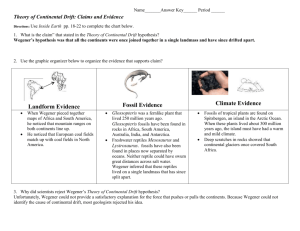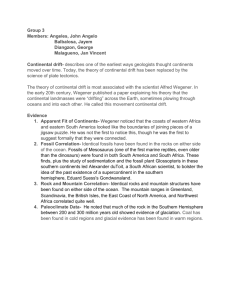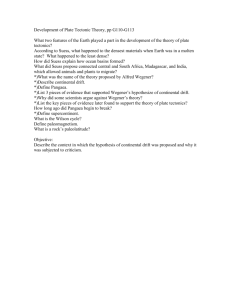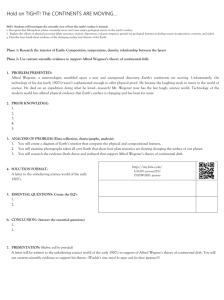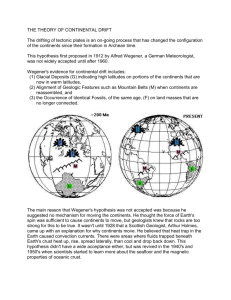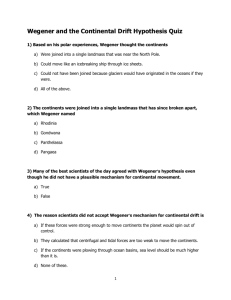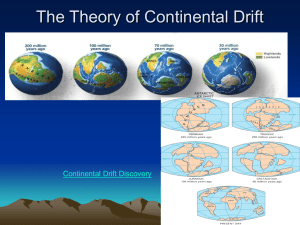The Theory of Continental Drift
advertisement
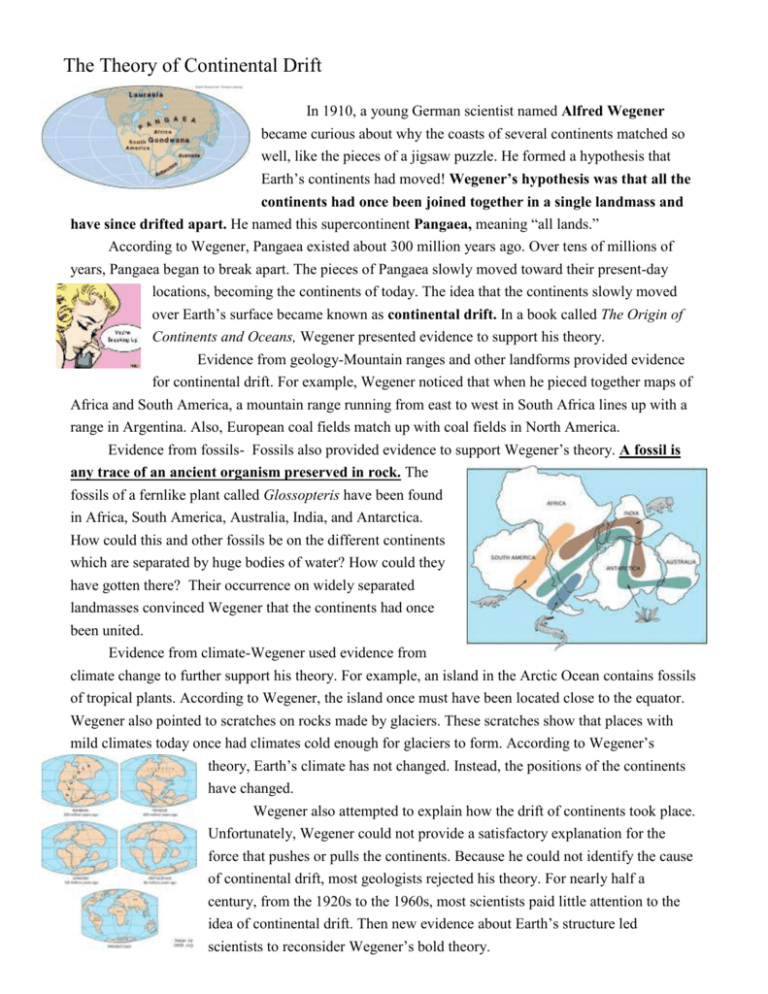
The Theory of Continental Drift In 1910, a young German scientist named Alfred Wegener became curious about why the coasts of several continents matched so well, like the pieces of a jigsaw puzzle. He formed a hypothesis that Earth’s continents had moved! Wegener’s hypothesis was that all the continents had once been joined together in a single landmass and have since drifted apart. He named this supercontinent Pangaea, meaning “all lands.” According to Wegener, Pangaea existed about 300 million years ago. Over tens of millions of years, Pangaea began to break apart. The pieces of Pangaea slowly moved toward their present-day locations, becoming the continents of today. The idea that the continents slowly moved over Earth’s surface became known as continental drift. In a book called The Origin of Continents and Oceans, Wegener presented evidence to support his theory. Evidence from geology-Mountain ranges and other landforms provided evidence for continental drift. For example, Wegener noticed that when he pieced together maps of Africa and South America, a mountain range running from east to west in South Africa lines up with a range in Argentina. Also, European coal fields match up with coal fields in North America. Evidence from fossils- Fossils also provided evidence to support Wegener’s theory. A fossil is any trace of an ancient organism preserved in rock. The fossils of a fernlike plant called Glossopteris have been found in Africa, South America, Australia, India, and Antarctica. How could this and other fossils be on the different continents which are separated by huge bodies of water? How could they have gotten there? Their occurrence on widely separated landmasses convinced Wegener that the continents had once been united. Evidence from climate-Wegener used evidence from climate change to further support his theory. For example, an island in the Arctic Ocean contains fossils of tropical plants. According to Wegener, the island once must have been located close to the equator. Wegener also pointed to scratches on rocks made by glaciers. These scratches show that places with mild climates today once had climates cold enough for glaciers to form. According to Wegener’s theory, Earth’s climate has not changed. Instead, the positions of the continents have changed. Wegener also attempted to explain how the drift of continents took place. Unfortunately, Wegener could not provide a satisfactory explanation for the force that pushes or pulls the continents. Because he could not identify the cause of continental drift, most geologists rejected his theory. For nearly half a century, from the 1920s to the 1960s, most scientists paid little attention to the idea of continental drift. Then new evidence about Earth’s structure led scientists to reconsider Wegener’s bold theory. Name______________________ The Theory of Continental Drift 1. State the hypothesis of continental drift. _________________________________________________ ___________________________________________________________________________________ 2. Who was the person that first researched the theory of continental drift? __________________________ 3. What did he notice that made him start thinking about it? _________________________________________________________________________________________ _________________________________________________________________________________________ 5. What is Pangaea? ____________________________________________________________________ 6. What happened to it? __________________________________________________________________ Besides the shape of the coastlines of the continents and how they fit together, Wegener used three other evidences to support his theory. Complete the list below of why he believed what he did. Type of Evidence Example of Evidence a. Mountain ranges in South America and 8. _______________________ line up Evidence from 7. _________________________ b. European coal fields match with similar coal fields in 9. _________________________ Evidence from 10._________________________ a. Fossils of the plants 11.____________________was found in rocks on widely separated landmasses. a. Fossils of 13. ______________plants found near the Arctic Ocean. Evidence from 12. _______________________ b. Scratches in rocks made by _______________14.were found in South Africa, 15. What is a fossil? ________________________________________________________________________ _________________________________________________________________________________________ 16. Why was Wegener’s theory not accepted by scientists during his lifetime? _________________________________________________________________________________________ 17. When would scientists start to agree with Wegener’s theory? ____________________________________ __________________________________________________________________________________

